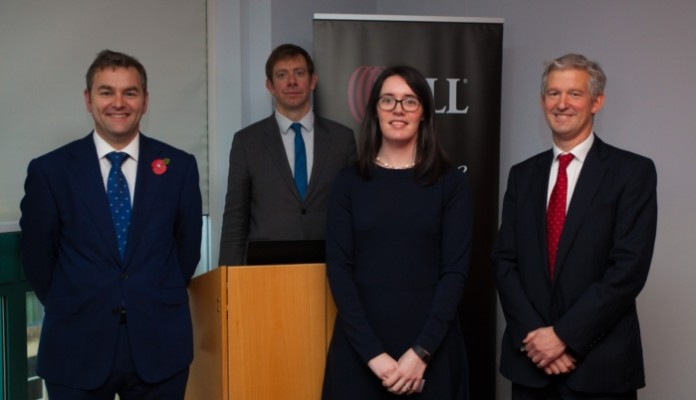Growing demand for office space in Edinburgh underlines the strength of Scotland’s economy but a lack of supply poses a threat to continued growth, attendees at JLL’s latest property seminar heard in Edinburgh on Tuesday 4 November.
At the seminar attended by over 60 guests from Scotland’s commercial property and investment community, JLL predicted record office occupier take up in Edinburgh for 2015 and a fall in vacancy rates, placing more strain on supply across Scotland’s capital.
In Edinburgh, office occupier take up for the year to date now sits at 605,000 sq ft and is set to significantly exceed the five year average of 650,000 sq ft. Vacancy rates in the capital have decreased from an 8% high in 2009 to 5.1%.
In Glasgow, headline office rentals have increased to over £30 per sq ft in 2015. Notably, three major office developments in Glasgow completed in 2015 – the first new build completions in over five years. The buildings, 1 West Regent Street, 110 St Vincent Street and St Vincent Plaza have already experienced strong letting activity.
As well as providing local market predictions for Edinburgh and Glasgow, Jon Neale, Head of UK Research at JLL, provided an overview on Scotland’s broader economic and property market trends. Neale predicted a strong outlook for Scotland’s economy, with GVA growth of 2% for 2016 compared to 1.7% in 2015, driven by a number of factors including continued low interest rates and strong retail sales.
Favourable economic conditions have also paved the path for an increase in investment volumes since 2008. Investment volumes in the first half of the year hit £31 billion, the highest first half on record (since 2004), and 10% above the previous peak in H1 2006. Investment in property across the UK, including Scotland, is characterised by the rise of overseas investment, which has accounted for 48% of all investment in the UK, compared to less than 20% back in 2004.
Karen Williamson, Associate Director of EMEA Research at JLL, also spoke at the event, discussing the changing workplace in 2016 and the impact of technology and workplace sustainability on sector trends.
Cameron Stott, Director at JLL said: “We’ve witnessed sustained levels of occupier demand throughout 2015, and with another anticipated drop in the availability of Grade A office supply in Edinburgh, demand looks set to outstrip supply. The development pipeline is becoming increasingly restricted, with new developments being pre-let well in advance of occupation. Coupled with increasing trends to convert cat B properties into hotels and residential developments, we’ve seen a significant drop in the levels of quality office space available in Edinburgh. JLL research suggests there is strong occupier demand for accommodation in the next two to four years which will be in line with the next wave of development, not expected to reach practical completion until late 2017.”
Jon Neale, UK Head of Research at JLL said: “With many investors increasingly asking where the market is in the current cycle, it is clear that Scotland’s cities still have some growth to come in both rents and capital values. Despite low borrowing costs, yields remain above the 2008 peak, take-up has been buoyant, and both cities are well placed to benefit from ‘nearshoring’ as larger businesses look to move some teams out of London. While economic growth this year may be down somewhat on 2014 owing to weaknesses in the oil & gas sector in particular, the strengths of professional services in both cities, and their growing tech and creative industries bode well for the future.”
Mike Buchan, Lead Director at JLL in Glasgow said: “2015 has been an interesting year for the Glasgow office market, with three significant completions coming to the market already securing significant lettings, indicating continued investor and occupier confidence in the city.
“With a particularly busy 2015 for the professional services sector, there is a concern around the lack of demand as we move into 2016. We do however anticipate rental growth in the mid-market sector and a renewed public sector interest in hub solutions as occupiers look to secure high-quality space in prime locations.”



















